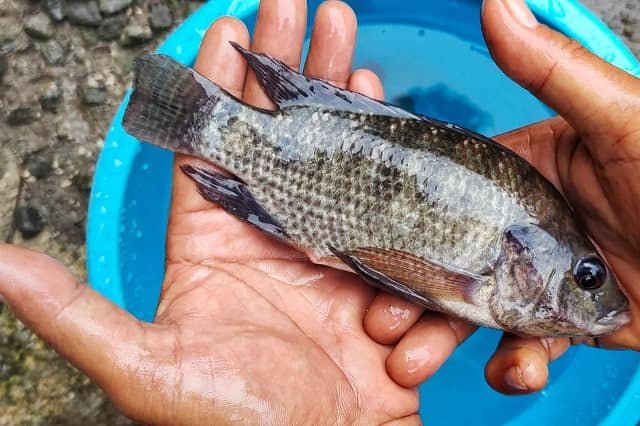
by Roslin Institute
Discovery of genes showing signatures of recent domestication could inform production of farmed Nile tilapia.
Scientists have identified genes showing evidence of breeding for desirable traits in one of the world’s most widely farmed fish, which could inform their production and have the potential to increase food security.
Genetic analysis revealed genes associated with muscle development and fillet yield in a region of the chromosome showing evidence of changes brought about by selection on the genome, either from environmental effects or human-mediated breeding. The finding makes the genetic variants in this region potential targets for selective breeding of fish for market, researchers say.
The research team used multiple strategies to describe genetic variation and characterise population structure in diverse strains of farmed Nile tilapia (Oreochromis niloticus) around the world and to identify regions of DNA possibly associated with selective breeding.
The study, by the Roslin Institute in collaboration with aquaculture research hub WorldFish and the Department of Fisheries Malaysia, is the first to apply a pooled sequencing approach to identifying genes under selection in Nile tilapia, allowing the analysis of DNA from multiple individuals simultaneously and generating rich data while driving down costs.
Enhanced understanding
The findings of this study provide valuable insights into the genetic makeup of farmed Nile tilapia populations, shedding light on the recent domestication process.
By better understanding patterns in this species’ genes, breeders can make informed decisions to enhance the productivity and sustainability of these farmed fish. The study also provided validation for the usefulness of an open access tool previously developed at the Roslin Institute to identify differences in the species’ genetic makeup.
The results of this study open new avenues for further research and advancement in Nile tilapia breeding programmes, contributing to the growth and development of aquaculture practices worldwide.
Conclusion
“Our research may benefit both the aquaculture industry and consumers by improving the quality and efficiency of Nile tilapia breeding. This study carries potential implications for the genetic management and improvement of Nile tilapia populations in order to meet the growing demand for sustainable seafood, and ensuring the long-term viability of tilapia farming”, said Dr Pam Weiner, Roslin Institute.
This research, published in Evolutionary Applications, was supported by the CGIAR Research Programme on Fish Agri-Food Systems (FISH) led by WorldFish.
Contact
Pamela Wiener
The Roslin Institute and Royal (Dick)
School of Veterinary Studies, University of Edinburgh Easter Bush,
Midlothian EH25 9RG, UK
Email: pam.wiener@roslin.ed.ac.uk
Reference (open access)
Barría, A., Peñaloza, C., Papadopoulou, A., Mahmuddin, M., Doeschl-Wilson, A., Benzie, J. A. H., Houston, R. D., & Wiener, P. (2023). Genetic differentiation following recent domestication events: A study of farmed Nile tilapia (Oreochromis niloticus) populations. Evolutionary Applications, 16, 1220– 1235. https://doi.org/10.1111/eva.13560
Editor at the digital magazine AquaHoy. He holds a degree in Aquaculture Biology from the National University of Santa (UNS) and a Master’s degree in Science and Innovation Management from the Polytechnic University of Valencia, with postgraduate diplomas in Business Innovation and Innovation Management. He possesses extensive experience in the aquaculture and fisheries sector, having led the Fisheries Innovation Unit of the National Program for Innovation in Fisheries and Aquaculture (PNIPA). He has served as a senior consultant in technology watch, an innovation project formulator and advisor, and a lecturer at UNS. He is a member of the Peruvian College of Biologists and was recognized by the World Aquaculture Society (WAS) in 2016 for his contribution to aquaculture.
